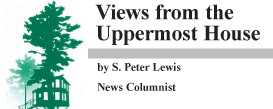The haberdashery of the back roads
April is nearly upon us, the time of the great transition, winter slowly trickling into spring; and with it comes the inevitable trepidation regarding what to toss over our shoulders when we walk through the mud room and out into the new air. It’s too cold for the down parka, too warm for the John Deere T-shirt — perhaps something in between would work, something that insulates while letting in just a little of the fresh breeze, something a bit worn.
over our shoulders when we walk through the mud room and out into the new air. It’s too cold for the down parka, too warm for the John Deere T-shirt — perhaps something in between would work, something that insulates while letting in just a little of the fresh breeze, something a bit worn.
In 1931, E.B. White, Maine’s great humorist and essay writer, quoted the simple declaration of his own tailor concerning outerwear during the transitional seasons, “It’s not every man that can afford to wear a shabby coat,†he wrote. White went on to speak of his own experiences with a threadbare jacket, describing it as his “one extravagance…a thin, inadequate garment, pneumonia written in every seam…what its peculiar charm is we don’t quite know.â€
I too have such a garment, a heavy work coat, brown and thready, gossamer in places, with a frayed hem, popped buttons, grease stains, jagged holes, and a torn pocket. A charming coat, perfect for April.
And, I know from whence comes its charm, for I found it in on a winding back road on a sunlit morning. I was driving on a woodsy spring errand many years ago, rounded a corner, and there was my new coat lying at the edge of the crumbly shoulder (mislaid and blown off the roof of some truck, probably), with one raggedy arm reaching out toward the centerline. I pulled over with tires screeching, astonished at my great fortune and hoping for a good fit. And when I slipped it on, shrugging the shoulders into place, shaking the sleeves down to the creases of my wrists, buttoning this and that, searching the pockets for treasure (one chewed carpenter’s pencil, a handful of drywall screws, a blown fuse), the pure glow of serendipity shown all around.
It became known at our house as “The Road Coat,†a moniker that was either a pejorative or a compliment, depending on the speaker. For instance, my wife, upon seeing me dressing for the day, might say, “You’re wearing the Road Coat to church?†To which I may well respond with, “Yes, I was thinking of wearing the Road Coat to church.†And though the phrasing appears nearly identical, a great gulf of inflection would stretch between us, distinguishable only by the slightly furrowing brow and the pursing lips. (After which I would sadly select a classy nylon windbreaker from the closet.)
My daughter, in particular, thought the Road Coat was utterly disgusting (and, by association, I suppose, she thought the same of me). “Gosh Dad, you’d wear anything you found in the road, wouldn’t you?†she said one day, scanning me head-to-toe as I donned my favorite shabby coat. I just smiled sheepishly. “Even socks?†she asked, pointing down toward my feet. “Well, if they fit…â€
Regardless of the criticism, I find the Road Coat transforming. When I slip it on and tromp out to the barn or the muddy garden, I cease to be a computer-gazing, Monday-through-Friday, nine-to-five man, becoming instead a man of the land, a woodsman, farmer, or mechanic, a man who can never quite get the black grime out of the creases in his calloused hands. I develop a loping gait, a squint, and the far-off gaze of a man who can smell sleet at a hundred miles. And when cars from Massachusetts pass our old homestead, I lean on my shovel or against the barn door, cross my rubber boots one over the other, pull my cap down low, and scowl.
I love my old Road Coat, and wouldn’t trade it for L.L. Bean’s finest. But it’s been a long time since that wondrous day when I found it — and my roads have since been barren. As you drive around, keep your eyes open for me, will you? I wear 30 x 32 pants and take my coats in medium. Socks only if they match. You can drop the stuff off at the newspaper office, where perhaps they’ll put a box in the corner with my name on it.
Peter Lewis resides in Bridgton.

